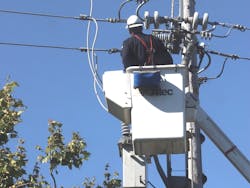If a microgrid is built in California to address public safety power shutoffs (PSPS), shouldn’t it also be activated when power outages occur for other reasons?
That’s the question a group representing 38 rural counties in California is asking state regulators after being precluded from using their microgrids during multiple power outages that were unrelated to PSPS — the planned shutdown of power by utilities to avoid wildfires.
Rural County Representatives of California, which includes communities located in forests with high fire risk, said that permit restrictions left microgrids sitting idle in their communities during “scores” of debilitating outages in 2021. Because the microgrids run on fossil fuels, the state limits their activation to the PSPS events.
“This has left local governments in the awkward position of having to explain to constituents that the much-touted utility microgrid can’t be turned on because the power outage was unexpected rather than planned by the utility,” said the group in comments filed with the California Public Utilities Commission (CPUC). “This is unfortunate because many of these projects were welcomed with open arms by the local communities and it was hoped they would provide real local resiliency. It was assumed locally that investment in a microgrid for PSPS mitigation would also be able to mitigate the impacts of other types of outages.”
Some of the outages occurred because of recent snowstorms, which in the Sierra Nevada area left some customers without power for nearly two weeks.
500 unplanned power outages
The counties also have experienced multiple power outages because of work that Pacific Gas & Electric began doing in July 2021 to improve its ability to avert wildfires. The utility is upgrading electrical equipment so that it can more quickly stop the flow of power when a problem is detected. The utility explains the program, called Enhanced Powerline Safety Settings (EPSS), here in a video.
“In some locations, these adjustments have resulted in more frequent outages as crews must patrol the circuit – and perform any necessary repairs – prior to restoring power,” the utility explains.
The program caused 500 unplanned power outages that affected more than 560,000 customers, according to an Oct. 25, 2021, letter to the utility from Marybel Batjer, CPUC president, who called for changes in the program.
In defense of the EPSS program, the utility said the work has drastically reduced wildfire risk. Since it was implemented, ignitions have fallen 46% in high fire threat areas, compared to the prior three-year average, and 80% on the improved circuits.
The rural county group wants the utility to seek local permits to ensure that the PSPS microgrids can be used for other kinds of outages. The group also pressed for the construction of additional utility microgrids to address the lack of electric reliability the counties face.
Microgrid incentive review
The issue is now being discussed before the commission as it reviews a $200 million microgrid incentive plan proposed by the state’s investor-owned utilities. The incentives would go to community, local and tribal microgrids.
In determining who gets the funds, the counties want to see more weight given to areas that have experienced the kind of outages they have — those caused by the EPSS repairs, bad weather or a history of poor electric reliability. As it’s proposed, the incentive scoring method would instead skew funding toward microgrids where there are frequent public safety power shutoffs, according to the counties.
Praise, but …
Much of the microgrid incentive program is winning praise from various stakeholder groups. But questions are being raised in the proceeding about the ability of the program to meet its goal of serving disadvantaged communities.
The Microgrid Equity Coalition is pushing for changes, saying the program discriminates against communities without means and reinforces institutionalized racism.
Formed by the California Alliance for Community Energy, the California Environmental Justice Alliance, the Sierra Club, The Climate Center and Vote Solar, the coalition cited financial barriers in the application process and a scoring system that works against disadvantaged communities by giving more points to projects that require fewer incentive dollars. The more vulnerable a community is, the greater its need will be for financial incentives to build microgrids, the coalition said.
“In practice, this problematic formula judges the cost-effectiveness of a project not based on its benefits to the targeted disadvantaged and vulnerable communities, but based on the resources of the applicant,” said the Microgrid Equity Coalition in its filing to the CPUC. “Those applicants who require little or no incentive dollars end up with a high project score, while those who require assistance are penalized.”
The scoring formula that has been proposed “completely contravenes” the purpose of the microgrid incentive program — which is to provide microgrid benefits equitably to disadvantaged vulnerable populations, the coalition said.
The incentive plan is part of a larger multiyear strategy by California regulators to help commercialize microgrids, as set out in state Senate Bill 1339. The state’s three investor-owned utilities filed the plan last month, and the public utilities commission expects to review it through April.
Interested in microgrids? Subscribe to the free Microgrid Knowledge Newsletter.







